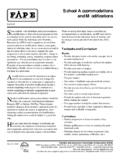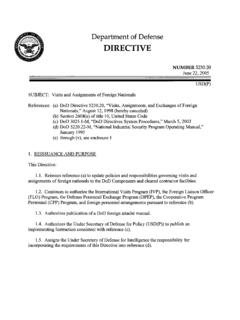Transcription of FORECASTING - University of North Carolina Wilmington
1 FORECASTING . module 4. FORECASTING Predict the next number in the pattern: a) , , , , , ? b) , , , , , ? c) , , , , , , , , ? FORECASTING Predict the next number in the pattern: a) , , , , , b) , , , , , c) , , , , , , , , Outline What is FORECASTING ? Types of forecasts Time-Series FORECASTING Good forecasts Monitoring forecasts FORECASTING What is FORECASTING ? Determining Future Events Based on Historical Facts and Data Some Thoughts on Forecasts Forecasts Tend to Be Wrong! Forecasts Can Be Biased!
2 (Marketing, Sales, etc.). Forecasts Tend to Be Better for Near Future So, Why Forecast? Better to Have Educated Guess About Future Than to Not Forecast At All! What is FORECASTING ? Process of predicting a future event based on historical data Educated guessing Sales will be $200 Million! Underlying basis of all business decisions Production Inventory Personnel Facilities Realities of FORECASTING Forecasts are seldom perfect Most FORECASTING methods assume that there is some underlying stability in the system Both product family and aggregated product forecasts are more accurate than individual product forecasts Why do we need to forecast?
3 In general, forecasts are almost always wrong. So, Throughout the day we forecast very different things such as weather, traffic, stock market, state of our company from different perspectives. Virtually every business attempt is based on FORECASTING . Not all of them are derived from sophisticated methods. However, Best" educated guesses about future are more valuable for purpose of Planning than no forecasts and hence no planning. Hochschule Bremen forecasts? Importance of FORECASTING in OM. Departments throughout the organization depend on forecasts to formulate and execute their plans.
4 Finance needs forecasts to project cash flows and capital requirements. Human resources need forecasts to anticipate hiring needs. Production needs forecasts to plan production levels, workforce, material requirements, inventories, etc. What departments in your University needs to forecast? Importance of FORECASTING in OM. Demand is not the only variable of interest to forecasters. Manufacturers also forecast worker absenteeism, machine availability, material costs, transportation and production lead times, etc.
5 Besides demand, service providers are also interested in forecasts of population, of other demographic variables, of weather, etc. Types of Forecasts by Time Horizon Quantitative Short-range forecast methods Usually < 3 months Job scheduling, worker assignments Detailed Medium-range forecast use of 3 months to 2 years system Sales/production planning Long-range forecast > 2 years New product planning Design of system Qualitative Methods Short vs. Long Term Medium/long range forecasts More comprehensive issues Support management decisions Short-term FORECASTING usually employs different methodologies than longer-term FORECASTING Short-term forecasts tend to be more accurate than longer- term forecasts How to Forecast?
6 Qualitative Methods Based On Educated Opinion & Judgment (Subjective). Particularly Useful When Lacking Numerical Data (Example: Design and Introduction Phases of a Product's Life Cycle). Quantitative Methods Based On Data (Objective). FORECASTING Approaches Qualitative Quantitative Used when situation is Used when situation is stable'. vague & little data exist & historical data exist New products Existing products New technology Current technology Involves intuition, Involves mathematical experience techniques , FORECASTING sales on.
7 FORECASTING sales of color Internet televisions Qualitative Methods Executive Judgment Sales Force Composite Market Research/Survey Delphi Method Jury of Executive Opinion Involves small group of high-level managers Group estimates demand by working together Combines managerial experience with statistical models Relatively quick Group-think' disadvantage Sales Force Composite Each salesperson projects his or her sales Sales Combined at district & national levels Sales reps know customers'. wants Tends to be overly optimistic 1995 Corel Corp.
8 Consumer Market Survey How many hours will Ask customers about purchasing you use the Internet plans next week? What consumers say, and what they actually do are often different Sometimes difficult to answer 1995 Corel Corp. 18. Delphi Method Iterative group process Decision Makers 3 types of people (Sales(Sales?). will be 50!). Decision makers Staff Staff (What will Respondents sales be? survey). Reduces group-think Respondents (Sales will be 45, 50, 55). Delphi Method As opposed to regular panels where the individuals involved are in direct communication, this method eliminates the effects of group potential dominance of the most vocal members.
9 The group involves individuals from inside as well as outside the organization. Typically, the procedure consists of the following steps: Each expert in the group makes his/her own forecasts in form of statements The coordinator collects all group statements and summarizes them The coordinator provides this summary and gives another set of questions to each group member including feedback as to the input of other experts. The above steps are repeated until a consensus is reached.. Quantitative Methods Time Series & Regression Time Series Popular FORECASTING Approach in Operations Management Assumption: Patterns That Occurred in the Past Will Continue to Occur In the Future Patterns Random Variation Trend Seasonality Composite What is a Time Series?
10 Obtained by observing response variable at regular time periods Set of evenly spaced numerical data Forecast based only on past values Assumes that factors influencing past and present will continue influence in future Assumes that factors influencing the past will continue to influence the future 1600 Monthly Champagne Sales 1400. 1200. 1000. 800. 600. 400. 200. 0. 0 12 24 36 48 60 72 84. Time (t). Trend Component Persistent, overall upward or downward pattern Due to population, technology etc. Several years duration Response Mo.







